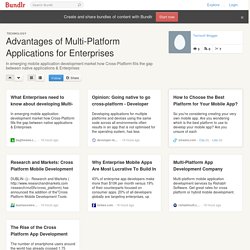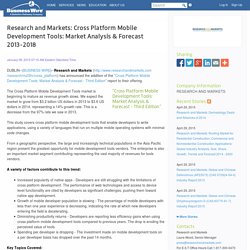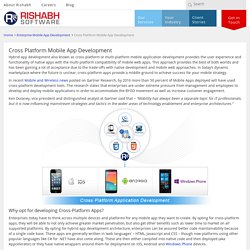

Advantages of Multi-Platform Applications for Enterprises. So you’re developing your very own mobile app.

Which platform should you choose? The popularity of mobile enterprise apps and consumer-based mobile apps has grown tremendously in the last decade. App stores are flooded with millions of mobile apps covering myriad topics and genres. Hundreds and thousands of new apps appear in app stores every day. Since app development can be a lucrative business, new app developers hoping to develop the next big thing are always on the horizon.
Reading about basic functionalities of iOS, Android, Windows and BlackBerry RIM doesn’t give you the full picture of the good, the bad and the ugly of each platform. Gartner Says by 2016, More Than 50 Percent of Mobile Apps Deployed Will be Hybrid. STAMFORD, Conn., February 4, 2013 View All Press Releases Gartner's 2013 Mobile and Wireless Predictions Reflect Mobility's Impact on the Broader With enterprises under extreme pressure from management and employees to develop and deploy mobile applications to accommodate mobile work styles and increase customer engagement, Gartner, Inc. predicts that more than 50 percent of mobile apps deployed by 2016 will be hybrid.

"Mobility has always been a separate topic for IT professionals, but it is now influencing mainstream strategies and tactics in the wider areas of technology enablement and enterprise architectures," said Ken Dulaney, vice president and distinguished analyst at Gartner. "Increasingly, enterprises are finding that they need to support multiple platforms, especially as the [bring your own device] BYOD trend gains momentum. " To address the need for mobile applications, enterprises are looking to leverage applications across multiple platforms.
Contacts About Gartner. Pros and Cons of PhoneGap App Development. Opinion: Going native to go cross-platform. (Image Credit: iStockPhoto/Charles Schug) We’d all love to be able to cut our workload by half, two-thirds or even more.

The problem is, less effort often means a compromise on quality. For instance, developing applications for multiple platforms and devices using the same code across all environments often results in an app that is not optimised for the operating system, has less functionality, and delivers poorer performance. Although the developer Holy Grail is to “write once, deploy anywhere,” the app wrap ― additional coding ― needed to develop native apps poses too great a challenge for there to be any silver bullet. However, there are new technologies, hybrid development tools and importantly, open source frameworks that certainly help relieve the development burden. Learning a specific language for a platform, such as Objective-C for iOS or Java for Android, can add a significant time pressure to our workload.
Other benefits are specific to each framework, but can include: How to Choose the Best Platform for Your Mobile App? So you’re developing your very own mobile app.

Which platform should you choose? The popularity of mobile enterprise apps and consumer-based mobile apps has grown tremendously in the last decade. App stores are flooded with millions of mobile apps covering myriad topics and genres. Hundreds and thousands of new apps appear in app stores every day. Since app development can be a lucrative business, new app developers hoping to develop the next big thing are always on the horizon.
Reading about basic functionalities of iOS, Android, Windows and BlackBerry RIM doesn’t give you the full picture of the good, the bad and the ugly of each platform. Research and Markets: Cross Platform Mobile Development Tools: Market Analysis & Forecast 2013-2018. DUBLIN--(BUSINESS WIRE)--Research and Markets ( has announced the addition of the "Cross Platform Mobile Development Tools: Market Analysis & Forecast - Third Edition" report to their offering.

“Cross Platform Mobile Development Tools: Market Analysis & Forecast - Third Edition” The Cross Platform Mobile Development Tools market is beginning to mature as revenue growth slows. We expect the market to grow from $3.2 billion US dollars in 2013 to $3.6 US dollars in 2014, representing a 14% growth rate. This is a decrease from the 97% rate we saw in 2013. Welcome to Forbes. The Rise of the Cross Platform App Development Market [INFOGRAPHIC] 65% Businesses are planning to develop cross platform The number of smartphone users around the world has already crossed 1.75 Billion users in 2014.
![The Rise of the Cross Platform App Development Market [INFOGRAPHIC]](http://cdn.pearltrees.com/s/pic/th/development-infographic-106983000)
This growth is very well reflected on the mobile phone industry as well with new smartphones been manufactured across different platforms on almost a daily basis. To reach this ever-growing market of new smartphone users across different platforms, launching a cross platform app is fast becoming a popular choice among mobile app developers.
More than 81% mobile developers actually claim that the quality of apps developed with cross-platform tools is as good or at times even surpasses that of native apps. With the growth in multi platform apps, it’s only natural that the tools and frameworks to develop them tend to mature overtime. The stats shown in the infographic are a good reflection on how the cross platform market is developing. Please see a comparative study of popular cross platform tools here. Multi-Platform App Development Company. Hybrid app development also known as cross-platform or multi-platform mobile application development provides the user experience and functionality of native apps with the multi-platform compatibility of mobile web apps.

This approach provides the best of both worlds and has been gaining a lot of acceptance due to the trade-offs with native development and mobile web approaches. In today’s dynamic marketplace where the future is unclear, cross-platform apps provide a middle ground to achieve success for your mobile strategy.